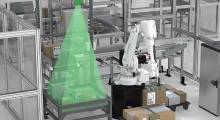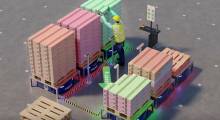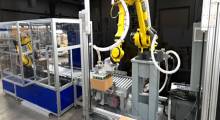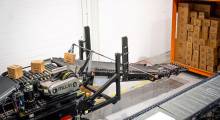Geekplus Technology Co. today announced that it has developed a new system for mixed case palletizing with WSR Solutions. The companies said their new product combines Geek+ mobile robots and WSR's palletizing algorithm to systematically handle the processing of multiple outbound orders in an efficient, safe, and flexible way.
“We are thrilled to work together with WSR Solutions to provide a tool that targets every aspect of the outbound logistics process, from how goods are stored and moved around the warehouse to how pallets are stacked,” stated Lit Fung, vice president of APAC, U.K., and the Americas at Geek+. “It can streamline] processes by eliminating the need for re-palletization and optimizing overall space utilization.”
Founded in 2014, WSR BV develops optimized end-of-line mixed palletizing systems for the global intralogistics market. The Deventer, Netherlands-based company has partners/resellers in Sweden, Italy, Lebanon, Spain, and the U.S.
Founded in 2015, Geek+ applies robotics and artificial intelligence to systems for warehouses and supply chain management. The Beijing-based company said it has 300 global customers and has sold more than 20,000 robots worldwide.
Geek+ AMRs work with WSR algorithms
Based on real-time demand, Geek+ autonomous mobile robots (AMRs) can optimize the movement of ordered goods between the storage area and picking station, said the company.
At the picking station, WSR’s intelligent algorithms enable the stacking of cases of varying weight, height, width, and so on in an optimal way, according to the partners. They claimed that it “is a one-stop solution that takes warehouse automation one step further, allowing operators to not only modernize logistics processes inside the warehouse, but [also] ensure agile supply chains through the efficient use of truck space.”
“Together with Geek+, we provide a full framework for the changing market requirements,” said Marcel van Schijndel, CEO of WSR Solutions. “Innovative mixed palletizing solutions ... serve one single goal: to optimize the customer's supply chain with efficient, flexible, and affordable automation solutions.”
The new system has four key components – storage area, buffer area, case picking area, and loading area, said Geek+ and WSR.
Storage area
The storage area is built on multiple layers using high-density racking and bulk lifts for more storage capacity. After inbound processing, pallets of incoming goods (donor pallets) are stored in high-density racking. Donor pallets are then moved horizontally by four-way shuttles and vertically by lifts.
The system can flexibly solve bottlenecks caused by rapid changes in required throughput, said Geek+. With no need for wires and long installation periods, the number of shuttles can be adjusted to handle changes in required throughput, and peak values can be changed using the system’s scheduling tool, it said.
Buffer area
Upon receiving the outbound order, items of high outbound volume go to a buffer area between the storage area and the workstation. Upon registering an incoming order, a robot picks up the donor pallet from the storage area and moves it to the buffer area for temporary storage.
At the buffer area, picking robots can streamline the movement of pallets, ensuring the smooth supply and optimal sequencing of source pallets to the workstation, Geek+ added.
Case picking area
At the workstation, an operator picks cases from a donor pallet and stacks them on an order pallet based on a pre-calculated stacking pattern, said Geek+. The user interface provides the operator with information on outbound orders such as required type and quantity of goods. The SAT laser pointer specifies case placement, according to the companies.
If one type of good is included in different orders, picking robots will move the donor pallet of that good to the next workstation, and new donor pallets containing other SKUs will automatically arrive at the previous workstation for continued order picking. The remaining items that do not require further picking will go to the storage area, creating a dynamic transit cycle, said Geek+.
Loading area
At the loading area, stacked pallets are loaded onto trucks by autonomous forklifts without the need for re-palletization. By optimizing how pallets are stacked it improves truck space utilization, lowering the overall transport costs, said WSR and Geek+.
WSR said its algorithm can enable efficient organization and order sequencing of large-scale, mixed-case combinations. It can be tailored to fit customers' actual business needs for allocation and priority management. The comopanies said their tool could be applicable to a wide range of industry scenarios.
Article topics
Email Sign Up



















